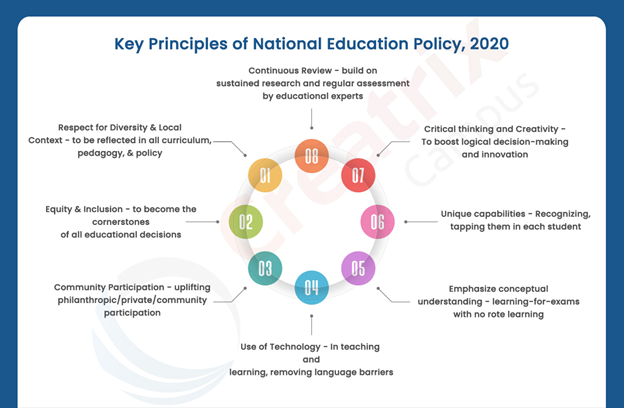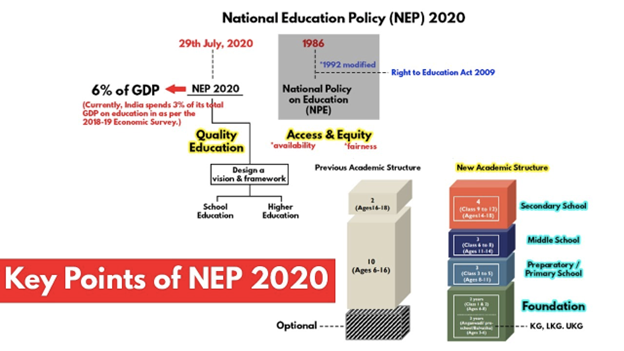Aligning higher education with the United Nations SDGs
Relevance
- GS Paper – 2, Government Policies & Interventions, Issues Relating to Poverty & Hunger.
- Tags: #SDG4 #NEP2020 #upsc #competitive-exams.
Why in the news?
- The recently released SDGs Report 2023 flagged slow progress and painted a grim picture due to the prolonged effects of COVID-19, the impacts of the climate crisis, the Russia-Ukraine conflict, and a weak global economy.
- The lack of progress towards the goals is a universal experience, but it has been more pronounced in the Least Developed Countries.
- India, despite having managed the crises of the global economy and relatively succeeded in overcoming the challenges posed by the pandemic, has suffered a setback in achieving these goals.
NEP 2020 and SDGs
- NEP 2020 has been prepared in tune with most of the SDGs. Though NEP 2020 calls for changes at all levels of education, priority should be accorded to higher education as it accelerates social mobility, empowers people through creativity and critical thinking, and grants them employment skills.
National Education Policy 2020
- The new National Education Policy (NEP) 2020 is the first education policy of the 21st century in India, which replaces the previous National Policy on Education (NPE) 1986.
- The Ministry of Education formed a committee under Dr. K Kasturirangan, which outlined this new policy.
- The National Education Policy 2020 proposes various reforms in school and higher education, including technical education, that are suited to 21st-century needs.
- 5 foundational pillars of NEP 2020: Access, Equity, Quality, Affordability, and Accountability.
- This policy is aligned with the 2030 Agenda for Sustainable Development.
- It aims to transform India into a vibrant knowledge society and global knowledge superpower by making both school and college education more holistic, flexible, and multidisciplinary and aimed at bringing out the unique capabilities of each student.
How is NEP 2020 different from the earlier policies?
- The National Policy on Education (NPE) was first formulated in 1968, based on the recommendations of the Kothari Commission.
- The NPE 1986 focussed on providing education to all sections of society, promoting primary education, and establishing open universities.
- Later, the Plan of Action (POA) 1992 had special emphasis on early childhood care and education and the universalization of elementary education.
The NEP 2020 stands apart and marks a departure from the earlier policies on the following grounds.
- Focus on holistic development: By emphasizing on critical thinking, discussion, and analytical learning to enrich India’s talent and human resource pool.
- Integration of vocational education: The policy recognizes the importance of vocational education and aims to integrate it with mainstream education.
- Emphasis on technology-enabled learning: The new education policy recognizes the importance of technology in education and encourages the use of digital tools and platforms to enhance the learning experience.
- Promotion of multilingualism along with the right to choose: The new policy emphasizes the importance of multilingualism and encourages the teaching of regional languages alongside English and Hindi with the much-needed flexibility.
- Flexible and multidisciplinary curriculum: NEP 2020 offers subject selection, software training in schools, transfer of credits, multiple entries, and exit system to allow for more internal autonomy to institutions.
What are the targets set under NEP 2020?
- Universalization of education from Early Childhood Care and Education (ECCE) to Secondary Education by 2030, aligning with SDG 4.
- Attaining Foundational Learning & Numeracy Skills through National Mission by 2025. 100% GER in Pre-School to Secondary Level by 2030.
- 50% GER in Higher Education by 2035. Bring back 2 Crore children to the mainstream through the open schooling system.
- Teachers to be prepared for assessment reforms by 2023. Inclusive & Equitable Education System by 2030.
What are the provisions of NEP 2020?
School Education
- Ensuring Universal Access at all levels of school education
- NEP 2020 emphasizes ensuring universal access to school education at all levels, from preschool to secondary.
- Early Childhood Care & Education with new curriculum and pedagogical structure
- With emphasis on Early Childhood Care and Education, the 10+2 structure of school curricula will be replaced by a 5+3+3+4 curricular structure.
- This will bring the hitherto uncovered age group of 3-6 years under the school curriculum, which has been recognized globally as the crucial stage for the development of the mental faculties of a child.
- Attaining Foundational Literacy and Numeracy
- As an urgent and necessary prerequisite to learning, NEP 2020 calls for setting up of a National Mission on Foundational Literacy and Numeracy.
- Reforms in school curricula and pedagogy
- Students will have increased flexibility and choice of subjects.
- There will be no rigid separations between arts and sciences, between curricular and extracurricular activities, and between vocational and academic streams.
- Vocational education will start in schools from the 6th grade and include internships.
- Teacher training and management
- The existing B.Ed. programme for teacher training will be replaced by a four-year integrated programme with high-quality content, pedagogy, and practical training.
- A national curriculum framework for teacher education will be formulated by the National Council for Teacher Education(NCTE) in consultation with NCERT.
- Multilingualism and the power of language
- The policy has emphasized the mother tongue as the medium of instruction until Grade 5, but preferably till Grade 8 and beyond.
- Sanskrit to be offered at all levels of school and higher education as an option for students, including in the three-language formula.
- Assessment and Accreditation
- A new National Assessment Centre-Performance Assessment, Review, and Analysis of Knowledge for Holistic Development (PARAKH) will be set up as a standard-setting body.
OECD Data in support of NEP 2020
- According to data from the Organisation for Economic Co-operation and Development (OECD), people with a higher education degree are more employable and earn an average of 54% more than those who only have completed senior secondary education.
- A university-inclusive education, thus, better protects people against poverty (SDG1), prevents them from hunger (SDG2), supports them for good health and well-being (SDG3), promotes gender equality (SDG5), provides them decent work, which in turn drives economic growth (SDG 8), and reduces inequalities (SDG10).
Steps to be taken to implement NEP 2020
- Universities should strengthen the research-teaching nexus in university education. That way, students will become direct benefactors of the knowledge generated from research.
- Multidisciplinary and interdisciplinary systems of education produce multitalented people who can pursue research, and find innovative solutions to global challenges such as affordable and clean energy (SDG7), sustainable cities and communities (SDG11), climate change and global warming (SDG13), as well as studying their impact on an economy and the earth.
- Sustainable development is possible only if we radically change the way we produce and consume (SDG12).
- Innovative solutions and start-ups (SDG 9) must be developed in collaboration with private companies. Introducing Value-Based Education (VBE) will help citizens become responsible towards self, society, and the planet and help our nation achieve “Life on Land” (SDG15).
- To accelerate the progress towards achieving the 2030 agenda, stakeholders of higher education should be educated and oriented so that none of their activities leave any SDG behind. The 56,205 higher educational institutions and universities in India should work together.
- Universities should come out reinvigorated and play a part in the education, innovation, culture, and civic life of their local communities. Community health, energy-saving measures, efficient resource allocation, waste reduction, development of local skills, as well as the sharing of services, infrastructure, and facilities with other universities or external partners should become a culture in universities.
Conclusion
- NEP 2020 demands that Indian higher education be committed to mapping its day-to-day operations with SDGs. Ranking universities according to the achievement of SDGs is a welcome move, but is still inadequate to meet the SDG deadline.
- The United Nations Sustainable Development Goals (SDGs) are a set of 17 goals with 169 targets that all 193 UN member states have agreed to try to achieve by 2030.
- SDGs are a matter of urgency, and actions by all countries, both developed and developing, to end poverty and other socio-economic and environmental problems should align with strategies that improve the standard of life and education, reduce inequality, and harness economic growth.
- It is high time that universities adopted sustainability as a mantra and incorporated SDGs into their institutional strategies, both in daily administration and in teaching and research.
- It has been realized that higher education cannot work in isolation; rather it must be directly integrated with socio-economic development where each activity and transaction has meaningful and multiple impacts on SDGs.
- Every citizen must feel that the universities contribute directly to their well-being and nation-building
Source: The Hindu
Mains Question
National Education Policy 2020 is in conformity with the Sustainable Development Goal-4 (2030). It intends to restructure and reorient the education system in India. Critically examine the statement.





